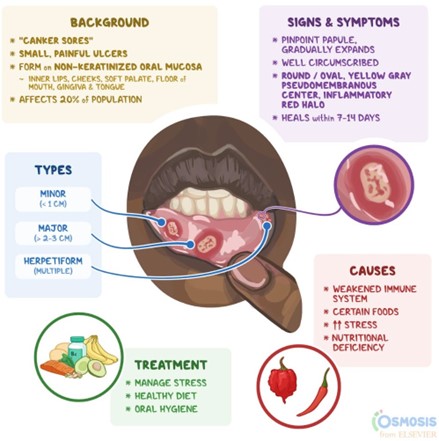The practical nurse (PN) learns that a client who is receiving chemotherapy has developed stomatitis.
Which information should the PN obtain from the client during a focused assessment?
Urinary output.
Ability to swallow.
Frequency of bowel movements.
Blood pressure while standing.
The Correct Answer is B
Stomatitis refers to the inflammation of the mouth and oral mucosa, which can cause pain and difficulty swallowing. In the context of a client receiving chemotherapy, stomatitis is a common side effect that can occur due to the effects of chemotherapy on rapidly dividing cells, including those in the oral cavity. When a client develops stomatitis, it is important for the practical nurse (PN) to obtain information about the client's ability to swallow during a focused assessment. This is because stomatitis can significantly impact a client's ability to eat and drink comfortably, which can lead to dehydration and malnutrition. Assessing the client's ability to swallow helps determine the extent of the issue and guides appropriate interventions and support.
Let's briefly evaluate the other options:
a) Urinary output.
Urinary output is not directly related to stomatitis. Stomatitis primarily affects the oral cavity, and its impact on urinary output is minimal or nonexistent. While monitoring urinary output is important for assessing hydration status, it is not the priority in this situation.
c) Frequency of bowel movements.
The frequency of bowel movements is unrelated to stomatitis. Stomatitis primarily affects the mouth, and its presence does not directly influence bowel movements. Assessing bowel movements may be relevant for other concerns, but it is not specifically related to stomatitis.
d) Blood pressure while standing.
Blood pressure while standing, also known as orthostatic blood pressure, is not directly relevant to stomatitis. Stomatitis primarily affects the oral cavity and does not typically have a direct impact on blood pressure. Assessing blood pressure while standing may be appropriate for other health concerns, such as orthostatic hypotension, but it is not the priority in this situation.
In summary, when a client receiving chemotherapy develops stomatitis, the practical nurse should focus on assessing the client's ability to swallow as it directly relates to the impact of stomatitis on the client's nutrition and hydration.

Nursing Test Bank
Naxlex Comprehensive Predictor Exams
Related Questions
Correct Answer is C
Explanation
Choice A rationale:
Ketonuria is not a common complication of diabetes insipidus. Ketonuria is associated with diabetes mellitus, a different condition that results in the accumulation of ketones in the urine due to insufficient insulin.
Choice B rationale:
Peripheral edema is also an unlikely complication of diabetes insipidus. Diabetes insipidus is characterized by excessive thirst and urination, not fluid retention or peripheral edema.
Correct Answer is B
Explanation
Choice A rationale:
Tenderness is not considered a normal finding during percussion of the abdomen. Tenderness suggests an underlying issue or inflammation in the abdominal area, which requires further evaluation and investigation.
Choice B rationale:
Musical and drumlike sounds are considered normal findings during percussion of the abdomen. These sounds indicate the presence of air-filled structures like the stomach or intestines. Normal abdominal percussion sounds are tympanic, and they are characterized by a hollow, drum-like quality when the abdomen is tapped lightly. This finding suggests that there are no significant abnormalities in the abdominal area.
Choice C rationale:
Absent sounds during abdominal percussion are not considered normal and may indicate a potential problem. Absent sounds could be due to factors such as bowel obstruction or severe constipation, which require further assessment and intervention.
Choice D rationale:
Pain during abdominal percussion is not considered a normal finding. It indicates discomfort or tenderness in the abdominal area, which requires further evaluation to determine the underlying cause.
Whether you are a student looking to ace your exams or a practicing nurse seeking to enhance your expertise , our nursing education contents will empower you with the confidence and competence to make a difference in the lives of patients and become a respected leader in the healthcare field.
Visit Naxlex, invest in your future and unlock endless possibilities with our unparalleled nursing education contents today
Report Wrong Answer on the Current Question
Do you disagree with the answer? If yes, what is your expected answer? Explain.
Kindly be descriptive with the issue you are facing.
